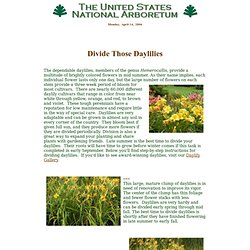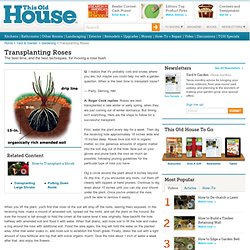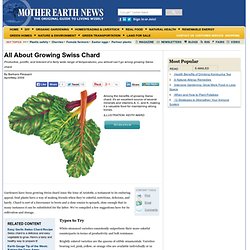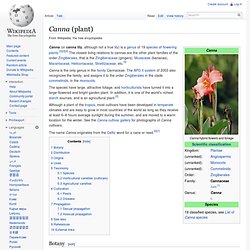

Cru.cahe.wsu.edu/CEPublications/PNW616/PNW616.pdf. The Official Seed Starting Home Page - Basil. How to Grow Radicchio. July 30th, 2008 Email 18 users recommend.

Www.ozaukeemastergardeners.org/New_Folder/Radicchio.pdf. How to grow Parsnips - all you need to know about growing Parsnips. The full flavour of parsnips do not emerge until the parsnip roots have been exposed to near freezing temperatures.

Because of this parsnips are known as a winter vegetable. Parsnips are a good source of carbohydrate, vitamin C, minerals such as potassium and calcium, and fibre. Parsnips can be safely left in the ground over winter and harvested the next spring if required. Dividing Daylilies. <<< This large, mature clump of daylilies is in need of renovation to improve its vigor.

The center of the clump has thin foliage and fewer flower stalks with less flowers. Tomato Dirt: growing tomatoes, gardening tips, tomato facts. Transplanting Roses. Q: I realize that it's probably cold and snowy where you are, but maybe you could help me with a garden question.

When is the best time to transplant roses? — Perry, Deming, NM A: Roger Cook replies: Roses are best transplanted in late winter or early spring, when they are just coming out of winter dormancy. But timing isn't everything. Here are the steps to follow for a successful transplant. First, water the plant every day for a week. The American Boxwood Society. All About Growing Swiss Chard. Gardeners have been growing Swiss chard since the time of Aristotle, a testament to its enduring appeal; food plants have a way of making friends when they’re colorful, nutritious, delicious, and hardy.

Chard is sort of a forerunner to beets and a close cousin to spinach, close enough that in many instances it can be substituted for the latter. We’ve compiled a few suggestions here for its cultivation and storage. Types to Try White-stemmed varieties consistently outperform their more colorful counterparts in terms of productivity and bolt resistance.
Brightly colored varieties are the queens of edible ornamentals. How to Grow Coriander and Cilantro. Bearded Iris for the Home Landscape. How to Plant, Grow and Purchase Coral Bells, Heuchera. Penstemon Website. 20 Apr 99 -- New pages for P. confusus and P. crandallii under the species sampler section. 9 Apr 99 -- I've added pages for P. ambiguus and P. barbatus.

I've recently scanned in a bunch of slides from last field season, so I will continue to add pages over the next few weeks. I'm also starting a list of links of interest to Penstemaniacs. This section will continue to grow, especially as I find sites that have linked to this one. I'm in the process of scanning in slides from the past two field seasons. Russian sage - Plant Encyclopedia - BHG.com. Stachys byzantina page. Stachys byzantina C.

Koch - Lamb's Ear Family - Lamiaceae Stems - To 50cm tall, multiple from base, erect to ascending, herbaceous, branching, 4-angled. Entire plant covered with very dense grey lanate pubescence. Leaves - Opposite, decussate, petiolate below to subsessile above. Canna (plant) Canna (or canna lily, although not a true lily) is a genus of 19 species of flowering plants.[2][3][4] The closest living relations to cannas are the other plant families of the order Zingiberales, that is the Zingiberaceae (gingers), Musaceae (bananas), Marantaceae, Heliconiaceae, Strelitziaceae, etc.[5] The species have large, attractive foliage, and horticulturists have turned it into a large-flowered and bright garden plant.

In addition, it is one of the world's richest starch sources, and is an agricultural plant.[5] The name Canna originates from the Celtic word for a cane or reed.[6][7] Pachysandra. Membership has its privileges As a Greenwood Garden Club Member you will receive: Place your order within 7 days and receive 10% off your first purchase Exclusive member pricing, which can run 10, 20 or even 30% lower than other regular prices found on the internet Login to your very own member page Create a wish list of Greenwood items Access links to Members' Only Sale Pages, special discount offers and Free Shipping promotions The Greenwood Newsletter -- emailed weekly during fall and spring, containing Cheryl's Gardening Notes and special promotions Join Now Already a Greenwood Garden Club Member?

Greenwood Garden Club Members please login to take advantage of member pricing, current specials and to access your member’s page. Log In Not a Greenwood Garden Club Member? Plant Details (Ligularia dentata ‘Britt-Marie Crawford’) Astilbe. Species[edit] Species of Astilbe include: Cultivar Groups[edit] Commonly accepted cultivar groups are:

Stachys byzantina. Lamb's Ear flowers in late spring and early summer, plants produce tall spike-like stems with a few reduced leaves. The flowers are small and either white or pink. Kniphofia uvaria. The Kniphofia genus is named after Johann Hieronymus Kniphof,[4] an 18th-century German physician and botanist.
Cultivars[edit] In addition to the species, many named cultivars of mixed or uncertain parentage have been selected for garden use. The following have gained the Royal Horticultural Society's Award of Garden Merit:- 'Bees' Sunset'[5] (yellow)'Brimstone Bloom'[6] (sulphur yellow)'Buttercup'[7] (clear yellow)'Nobilis'[8] (evergreen, orange and yellow)K. rooperi[9] (evergreen, oval spikes of red and yellow flowers)'Royal Standard'[10] (red and yellow)'Samuel's Sensation'[11] (tall herbaceous variety, scarlet flowers fading to yellow at the base)'Sunningdale Yellow'[12] (orange-yellow)'Tawny King'[13] (cream/brown)'Toffee Nosed'[14] (cream/brown)'Wrexham Buttercup'[15] (yellow) Some species[edit]